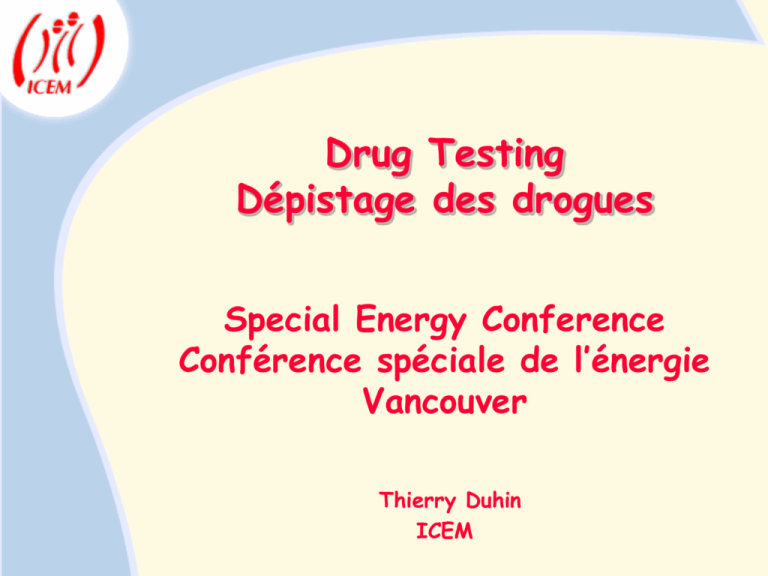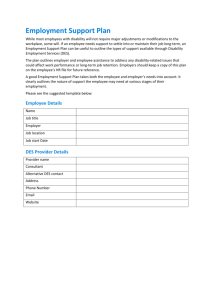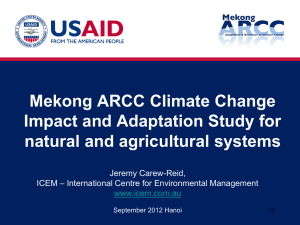here - IndustriALL Global Union
advertisement

Drug Testing Dépistage des drogues Special Energy Conference Conférence spéciale de l’énergie Vancouver Thierry Duhin ICEM Outline – En bref Brief overview of the ICEM Bref survol de l’ICEM Drug testing worldwide Dépistage des drogues dans le monde Union and other positions Positions syndicales et autres Possible attitudes Attitudes possibles International Federation of Chemical, Energy, Mine and General Workers' Unions Fédération internationale des syndicats de travailleurs de la chimie, de l'énergie, des mines et des industries diverses Affiliés 389 Affiliates Pays 122 Countries Membres 20 000 000 Members Industries Energy (Oil, Gas, Electric Power) Energies (Pétrole, gaz, électricité) Mining & DGOJP Mines et DGOJP Chemical & Bio-Science (Pharmaceuticals) Chimie et bio-sciences (Pharmacie) Rubber (Tyre, Other Rubber) Caoutchouc (pneus, autres) Materials (Glass, Ceramics, Cement) Matériaux (verre, céramique, ciment) Pulp & Paper Pâte et papier Services and Miscellaneous Services et divers Regions Asia / Pacific Asie et Pacifique Central Europe Europe centrale Eastern Europe, Central Asia and Trans-Caucasus Europe orientale, Asie centrale et Tran-Caucase Nordic Countries Pays nordiques North Africa and Middle East Afrique du Nord et Moyen-Orient North America Amérique du Nord South and Central Africa Afrique australe et centrale South and Central America & the Caribbean Amérique du Sud et Centrale & Caraïbes Western Europe Europe occidentale 21st Century Energy – The ICEM Vision Energie au 21è Siècle – La vision de l’ICEM We want safe, affordable, accessible energy Nous voulons une énergie sure, abordable et accéssible We want good jobs in sustainable industries Nous voulons des emplois de qualité dans des industries durables Workers are key stakeholders Les travailleurs sont des acteurs-clé Achievement of just, equitable and sustainable societies Obtention de sociétés justes, équitables et durables No to narrow finance driven models Non à des modèles financiers étroits Developing Global Agreements Développement d’Accords mondiaux Building Regional and Global Networks Construction de réseaux régionaux et mondiaux ICEM Global Agreements Company Country Statoil Norway Employees Signed 17 000 Jul 1998 Freudenberg Germany 30 000 Jun 2000 Endesa 28 000 Jan 2002 Norske Skog Norway 11 000 Jun 2002 Anglogold South Africa 53 000 Sep 2002 ENI Italy 70 000 Nov 2002 RAG Germany 92 000 Aug 2003 SCA Sweden 45 000 Apr 2004 Lukoil Russia 96 000 May 2004 EDF France 167 000 Jan 2005 Rhodia France 20 000 Feb 2005 Lafarge France 77 000 Sep 2005 Spain 706 000 www.icem.org www.icem.org Workplace Drug Testing How it all started ‘War against drug’ in the US Since 1960’s drug abuse a concern Ronald Reagan’s Drug-Free Workplace Act of 1988 Where we stand (US figures) 1983 less than 1% Nowadays, about half of the full-time workers aged 18-49 Up 277 % from 1987 Junk science The ‘Firestone Study’ $100-billion in lost productivity 2.5 times more absence 3.6 more accidents 5 times more compensation claims How reliable are the tests? Depronil (to treat Parkinson’s disease) shows up as amphetamine Codeine (used in some pain-killers) shows as morphine Ibuprofen (over-the-counter anti-inflammatory) shows up as marijuana Poppy seed in bakery shows up as heroine What the law says USA NOT required under the 1988 Act Most private employers have the right to test In unionized workforces, the implementation of testing programs must be negotiated. What the law says UK The following legislation is applicable: The Health and Safety at Work Act 1974 The Safety Representatives and Safety Committee Regulations Act 1977 The Road Traffic Act 1988 The Misuse of Drugs Act 1971 The Transport and Works Act 1992 The Data Protection Act 1998 What the law says Canada No legislation for nor against Canadian Human Rights Commission policy on drug testing It’s an industry of its own 2.5 times more absence 3.6 more accidents 5 times more compensation Real world facts and figures: Between 20 and 50m tests a year Up to $1,5 billion a year excluding service fees Situation in several countries USA ICEM affiliate USWA Few successes with challenges Substance abuse in the industry remains an unresolved issue Situation in several countries UK ICEM affiliate AMICUS Education programmes Negotiation in six stages 1) Consultation between trade union representatives and employers 2) The framework of the policy should contain information on aims, responsibility, definition, education, training, support, confidentiality, disciplinary action and monitoring and reviewing 3) Decision to be made on testing 4) Reaching agreement 5) Implementation of the policy 6) Monitoring and reviewing Situation in several countries Australia Formal and informal policies and practices Developed in an ad hoc manner Employee assistance programs (EAPs) Situation in several countries Azerbaijan ICEM affiliate Oil and Gas Workers’ Union Drugs and alcohol dependency do not have the scale of a problem. Youth involvement work Recommendations Specific union efforts on off-shore installations Part of general health and safety prevention Situation in several countries Belgium No specific legislation General Medical Council has established strict guidelines in 1993 ICEM affiliate La Centrale Générale ExxonMobil’s Policy on Alcohol and Drugs Problem that can be dealt with Situation in several countries Denmark No legislation The offshore sector has introduced guidelines The union has accepted them ICEM affiliate EL-Forbund No agreement over WDT. Danish Confederation of Trade Unions has Situation in several countries Finland Mostly pre-employment testing Usually workplaces negotiated ICEM affiliate Kemianliitto The Finnish energy company Fortum has adopted a programme on prevention of drugs and the misuse of alcohol on January this year. Situation in several countries Croatia ICEM affiliate EKN Not the part of collective agreements One recent court case Situation in several countries Chile WDT requires a company policy Never compulsory If in the works regulations, disciplinary measures can be taken Situation in several countries Puerto Rico Ley 59, 1997 specifically addresses WDT Legal in the private sector Employer has to have a clear policy When unionized, part of the collective agreement Situation in several countries Greece Only at the pre-employment stage, for Security Services (law of 1997) Situation in several countries Ireland No legislation Most of the testing is at the pre-employment level mostly by companies having their parent company in the US Situation in several countries Luxembourg No specific legislation HIV-test is forbidden. Some private companies do WDT Situation in several countries Portugal No law Tripartite dialogue in 1999 No regulations have been enforced Situation in several countries Sweden No law Usually negotiated between employer and employees Situation in several countries Switzerland Drugs of Abuse Testing Guidelines by the Swiss Working Group for Drugs of Abuse Recommendations not legally binding WDT is only performed in the area of public transportation, military, private schools, and very few private companies (like car industry, pharmaceutical industry), mainly in form of preemployment testing. Situation in several countries The Netherlands There is no legislation Pre employment drug testing prohibited by law WDT considered an infringement of the individual privacy. Exists in petrochemical or shipping industry Employees have the right to refuse. Agreement about procedures between the employer and the workers council What the ILO says Ce que dit l’OIT Guiding principles on drug and alcohol testing in the workplace Interregional Tripartite Experts Meeting on Drug and Alcohol Testing in the Workplace, 1993 Principes directeurs relatifs à la détection de l'alcool et des drogues sur le lieu de travail, Réunion tripartite interrégionale d'experts sur la détection de l'alcool et des drogues sur le lieu de travail, 1993 What the ILO says Overview Formal written policy Consensus Effectiveness of drug testing Scientific evidence is equivocal No sufficient evidence to show that WDT improve productivity and safety in the workplace. What the ILO says Programme outcomes Intended outcomes may include: programme to improve safety and security as well as to reduce potential legal liabilities. Reduction of absenteeism. Unintended outcomes may include: Deterioration of the work environment: fear, mistrust, polarization between management and workers, lack of openness, and increased social control. Not following legal and ethical rules. Breaches of confidentiality. Adverse effects on individuals as a result of errors in testing. Decrease in security of employment. What the ILO says Legal and ethical issues Specific procedures legislation on workplace drug and alcohol testing labour law medical confidentiality laws Universal Declaration of Human Rights and international labour standards What the ILO says Programme organization and development Programme policy statement Confidentiality Programme linkages Policy options/purposes – investigations of accidents and incidents; – referral for assistance; – deterrence; – meeting legal and regulatory requirements; – communicating an organization's policy. What the ILO says Technical and scientific issues The working group recognizes that national and international standards are lacking. Extreme caution must be exercised in the testing procedures. A positive result does not automatically identify an individual as a drug user. What the ILO says Recommendations for action and research Research should be undertaken Evaluate the costs and benefits of WDT The ILO should consider the need for developing international standards for drug and alcohol testing and laboratory certification. A ‘civil society’ position The report from the Independent Inquiry on Drug Testing at Work (IIDTW) set up at the initiative of the Joseph Rowntree Foundation sets out and considers the arguments on drug testing at work, and concludes with a set of detailed recommendations. A ‘civil society’ position Key findings of the IIDTW The evidence on the links was inconclusive. Lack of evidence for a strong link between drug use and accidents in safety-critical industries Other factors may have a greater impact on safety, productivity and performance Alcohol is probably a greater cause for concern in the workplace than illicit drugs. There is no clear evidence that drug testing at work has a significant deterrent effect. Drug testing will reveal information that can have no impact on safety, productivity or performance. Empowering employers to investigate private behaviour actively is in conflict with liberal-democratic values. Legal position on drug testing at work is confused. Costs A ‘civil society’ position Key recommendations of IIDWT Legitimate in a restricted set of circumstances only: - Illegal activities in the workplace; - Intoxicated in work hours; - Demonstrable impact on employees' performance - As reasonable steps to minimize the risk of accident - Nature of the work (e.g. police or prison service). Need for continued research Accreditation for providers of drug testing services is unsatisfactory The government should produce clear and definitive guidance Health and welfare issue as well as a disciplinary matter Introduced following proper consultation Good and open management is the most effective method How to make it ‘acceptable’? Policy model (from British TUC’s WorkSmart) A statement of the policy's aims, and to whom it applies. An indication of who is responsible for carrying out the policy. A definition of drug misuse. Rules about how employees are expected to behave. Safeguards making it clear that absence for treatment and rehabilitation is covered by normal sickness absence, and recognition that relapses may occur. Assurance that employees with drug problems will be treated in confidence, subject to the law. A description of support available to employees with drug problems, and a statement encouraging employees with drug problems to seek help voluntarily. A commitment to providing all employees with general information about drugs and their impact on health and safety. Details of the disciplinary procedures, for example stating that possession/dealing will be automatically reported to the police. Concluding remarks It’s a concept that may ‘feel right’ for companies but that has very little to actually support it Except for alcohol, there is no standard for impairment Companies are worried about their image. They’re afraid that if they don’t support drug testing it implies they support drug use It raises justified fears about ‘big-brotherism’ When there are valid reasons for testing, clear policies acceptable to the workers must be negotiated with the unions In terms of workplace alcohol and drug abuse, employee assistance programs should be the focus rather than testing mainly aimed at disciplinary actions.







